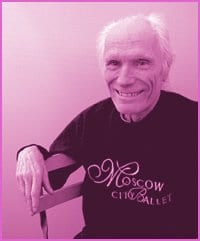“We all smoked in those days.” Retired ballet dancer Ian Robertson sits back in his favourite chair, legs crossed, holding his cigarette aloft in his right hand. “I would say about 90 percent of us did. I got lung cancer about four years ago so it did slow me down in the end.”
As a 15-year-old in 1955, Robertson worried he might be perceived as gay for taking up ballet, “so I snuck away to dance classes as a kid.”
He was a natural dancer. At 17, he studied with a Russian teacher in Toronto for a year and got a professional dancing contract with the National Ballet. His eyes twinkle. “I was well-trained in that one year but that’s still very little training for a professional dance career.”
He spent three years with the National Ballet touring Canada and the US, and then went to England, where he danced in The Music Man in London’s West End.
“Wherever we danced, we’d go out to the gay bars after. I got to see the gay bars of the entire world, pretty well.
“Not in Russia,” he amends. “Russia was very, very secretive. It was a crime. One had to be discreet.”
That sense of discretion helped Robertson smuggle a small fortune in jewels back into the then-USSR for Russian ballet legend Rudolph Nureyev’s family after Nureyev defected from the Kirov Ballet in 1961 in a French airport. “I helped his family but I had to be very quiet.”
He remembers being spellbound by the celebrity. “He was the biggest star we’d ever seen. I don’t think there was, in this last century, a bigger star. He put male dancing on the map again. Nureyev was my hero, so to meet him and be entrusted with a mission” he sighs.
Robertson first met the star when he was invited to study as an apprentice with Nureyev’s teacher in Russia in the early ’60s. “I met him on my 23rd birthday just before I went. He gave me some jewels to wear, to hide, to take to his teacher to sell and give money to his family. It was just after he defected.
“They were aquamarines, two strands of them in solid gold chain,” Robertson recalls. “They were worth thousands and thousands.”
The teacher and his wife took care of him. He studied with a younger student “who was Baryshnikov,” he grins, “so I was in very good company.” Another Russian ballet great of the same era, Mikhail Baryshnikov defected to Canada during a Kirov Ballet tour in 1974.
Robertson looks back to those days as the high point of his career and quite possibly his life. “It was very inspiring having danced with the Russian Ballet, with the Kirov, with the greats and being part of the very greatest dancers of the day. There’s an allure that’s part of theatre. I fell in love with it. The moment I put my hand on the barre I felt like I’d come home. It seemed so natural to me.”
Years later, Robertson returned to Russia to complete his formal training in Classical Russian Ballet. “I did my two-year teacher’s course and I have the first teacher’s diploma of a Westerner from that school ever in their history.” That school, called The Imperial Russian Ballet School before the Russian Revolution, is now The Vaganova Academy of Russian Ballet.
His stellar start in the ballet world ended unexpectedly in the ’70s when, at 29 years old, he ruptured all the ligaments in his knee while rehearsing. “That’s what ended my career.”
Robertson was in Switzerland at the time, where they’re used to ski injuries and had very good orthopedic surgeons. They mended it but his knee was never the same. “I was still employed and they gave me principle roles but they were more mime roles and I loved the athletic. I had a big jump. I had a good, strong technique after Russia and with that gone I felt that I would have to be relegated to secondary roles.”
Robertson sunk into a deep depression and drank heavily for the next 10 years. A friend got him into a treatment centre in Vancouver 1983. He was 43.
Then, ten years ago, he was diagnosed with AIDS, following a gaybashing/robbery in Mexico that left him “beaten to the point where I had to go to the hospital. The test results came back ‘suspicions of AIDS.'”
He came back to Vancouver, leaving behind a dance school that he’d spent several years working on. “It was the year of the AIDS Conference here-the year of the cocktail. So I went straight on it. I had lost many friends in the few years before that so it certainly was a death sentence, or it seemed to be.”
That perceived death sentence made Robertson re-evaluate his priorities. “It’s allowed me to progress towards fulfilling what I kind of feel is a mission-to show good Russian Classical Ballet in Canada.”
He describes himself as a real conservative when it comes to dance. “I’m not a conservative in any other way,” he laughs, “but as far as our tradition goes I think it’s worth conserving.”
At this point, for him, it’s about teaching the young ones. “My real accomplishment, I hope, will be in the re-seeding of the true classical ballet here.” He hopes to bring the Moscow City Ballet to Canada in 2006 to give the next generation of dancers something to aspire to.
“They really should have an inspiration,” he says. “That’s what will keep them dancing-a dream. And if they don’t see it in front of them, the magic, how can you make them work that hard, year after year, really?”

 Why you can trust Xtra
Why you can trust Xtra


